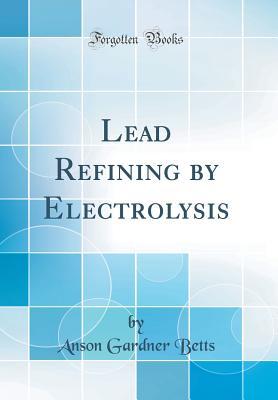Read Lead Refining by Electrolysis (Classic Reprint) - Anson Gardner Betts file in ePub
Related searches:
In chemistry and manufacturing, electrolysis is a technique that uses direct electric current (dc) to drive an otherwise non-spontaneous chemical reaction. Electrolysis is commercially important as a stage in the separation of elements from naturally occurring sources such as ores using an electrolytic cell.
Lead refining by electrolysis (classic reprint) anson gardner betts no preview available - 2017. Lead refining by electrolysis anson gardner betts no preview.
There are many kinds of materials that yield pure gold, platinum, or silver when refined. Though it's usually a little intimidating the first time you do anything, refining precious metals yourself is relatively easy to do (even with no experience) provided you have the right information, supplies, and equipment.
Electrolysis or electrolytic refining is a technique used for extraction as well as purification of metals obtained by any refining method. In the electro- refining process, a block of impure metal is made the anode and a thin sheet of metal is made the cathode.
For example, lead bromide contains positively charged lead ions and negatively charged bromide ions. Electrolysis is the process by which ionic substances are decomposed (broken down) into simpler.
Process description the aim of lead refining is to produce sellable lead metal. This is done in a refining kettle by separating out unwanted accompanying elements and alloying. After copper has been separated out, arsenic, tin and antimony are removed from the lead melt.
Electrolytic refining of copper means its refining by electrolysis method. Many metals like copper, zinc, tin lead are refined by this method. Process of electrolytic refining is described below: firstly the apparatus for the electrolysis consist of electrolytic tank containing acidified copper sulphate solution as electrolyte.
Lead refining by electrolysis [gardner, betts anson] on amazon.
“the beauty of lead is that unlike any other battery type it is 100% recyclable,” said steve cotton, chief commercial officer of aqua metals. Lead recycling is typically done though a process called smelting. Smelting is a highly toxic and highly polluting process as the batteries are being heated at high temperatures to extract the lead.
Publication date 1908 topics lead -- electrometallurgy publisher new york� wiley collection cdl; americana.
The process of purifying impure metal is called refining of metal. The most important and most widely used method for refining impure metals is called electrolytic refining. Many metals like copper, zinc, tin, lead, nickel, silver, gold are refined electrolytically.
The direct electrorefining of anode particles obtained from lead acid battery sludge to produce electrolytic lead powder without application of the conventional leaching process is the aim of this.
In refining electrolysis in hexafluorosilic acid with current densities of 100 a/m 2, it is possible to separate bismuth and antimony from prerefined lead bullion. Pure lead with less than 50 ppm bismuth and less than 100 ppm antimony was deposited at the cathode.
A solution of lead-fluosilicate, containing an excess of fluosilicic acid, has been found to work very satisfactorily as an electrolyte for refining lead. It conducts the current well, is easily handled and stored, non-volatile and stable under electrolysis, may be made to contain a considerable amount of dissolved lead, and is easily prepared from inexpensive materials.
Lead processing, preparation of the ore for use in various products. Lead (pb) is one of the oldest metals known, being one of seven metals used in the ancient world (the others are gold, silver, copper, iron, tin, and mercury). Its low melting point of 327 °c (621 °f), coupled with its easy.
When reduction is complete, the furnace is tapped and the lead drawn off to flow into drossing kettles or molds. At this stage, the semifinished product, 95 to 99 percent lead and containing dissolved metallic and nonmetallic (oxide and sulfide) impurities, is known as base bullion.
What is electrolytic refining? electrolytic refining is a process of refining a metal (mainly copper) by the process of electrolysis. As far as the mechanism of the process is concerned, during electrolysis, a large chunk or slab of impure metal is used as the anode with a thin strip of pure metal at the cathode.
7 7) chromatographic method purification or refining of metals the metal obtained by any of the above methods is usually impure and is known as crude metal.
The lead-refining process is described as, “ after copper drossing, generally te, as, sn and sb are removed substantially by the harris refining process using fused naoh. A certain selectivity during refining is achieved by controlled addition of nano3. Another refining step is decopperizing by means of elemental sulfur.
When going through one of my chemistry textbooks, i saw that the electrolysis of aqueous lead nitrate led to oxygen being formed at the anode and lead being formed at the cathode. However, in school, i was taught that only metals less reactive than hydrogen will form at the cathode.
At the end of approkimately four hours, the electrolysis was stopped as the anode was again becoming badly coated with a brownish-black coating. Still in hopes of getting the lead into solution as a nitrate, a third electrolysis was started with the same electrolyte as used in experiment number two except that.
The cupel absorbs some portions of the impurities, and the rest vaporises, leaving behind the pure silver or gold. This method also purifies molten pig iron within a bessemer converter. The most common refining process against impurities is electrolytic process.

Post Your Comments: